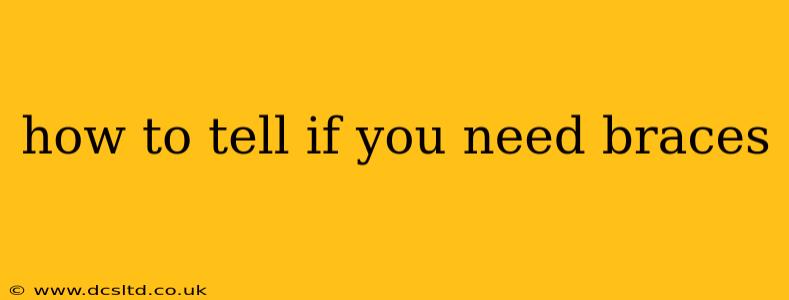Considering braces? It's a big decision, impacting both your appearance and oral health. This comprehensive guide will help you understand the signs that you might need orthodontic treatment. We'll explore common indicators, address frequently asked questions, and ultimately empower you to make an informed choice about your smile.
What are the Signs You Need Braces?
Several factors indicate the potential need for braces. These range from purely cosmetic concerns to serious dental health issues. Let's examine the key signs:
-
Overcrowding: If your teeth are too crowded, making it difficult to properly clean them, you may need braces to realign them and prevent potential problems. This is a common reason for orthodontic treatment.
-
Spacing: Gaps between your teeth, while sometimes considered aesthetically pleasing, can also lead to difficulties in chewing and cleaning. Braces can close these gaps and improve overall oral health.
-
Crossbite: This occurs when your upper teeth fit inside your lower teeth, instead of overlapping them. A crossbite can lead to jaw problems and uneven wear on teeth.
-
Underbite: An underbite is when your lower teeth protrude significantly beyond your upper teeth. This can impact chewing, speech, and jaw alignment.
-
Overbite: An overbite is the opposite of an underbite – your upper teeth excessively overlap your lower teeth. Severe overbites can affect chewing and may cause wear on the lower teeth.
-
Open Bite: This is when there's a gap between your upper and lower teeth when you bite down. It can affect speech and chewing, and often requires orthodontic correction.
What are the Common Problems Caused by Crooked Teeth?
Beyond aesthetics, misaligned teeth can have several negative consequences:
-
Increased Risk of Cavities and Gum Disease: Crooked teeth are harder to clean effectively, leading to a build-up of plaque and bacteria. This increases the risk of cavities and gum disease.
-
Difficulty Chewing and Speaking: Severe misalignment can impact your ability to chew food properly and speak clearly.
-
Temporomandibular Joint (TMJ) Disorders: Misalignment can put undue stress on the temporomandibular joint (TMJ), which connects your jaw to your skull, leading to pain and discomfort.
-
Low Self-Esteem: For many people, a straight, healthy smile contributes significantly to their self-confidence.
How Can I Know for Sure if I Need Braces?
Self-diagnosis is not sufficient. While the above signs indicate a potential need for braces, only a qualified orthodontist can make an accurate assessment.
What Happens During an Orthodontic Consultation?
During your consultation, the orthodontist will conduct a thorough examination of your teeth and jaws. This will involve:
-
Visual Inspection: The orthodontist will examine your teeth and jaw alignment.
-
X-rays: X-rays will provide a detailed view of your teeth and jaw structure, helping to identify any underlying issues.
-
Dental Impressions: Impressions will be taken to create a precise model of your teeth.
-
Discussion of Treatment Options: Based on the assessment, the orthodontist will discuss the available treatment options, including the type of braces (traditional metal braces, ceramic braces, Invisalign, etc.), and the estimated treatment duration.
At What Age Should I Consult an Orthodontist?
The American Association of Orthodontists recommends that children have their first orthodontic check-up by age 7. Early intervention can help prevent more serious problems later on. However, adults can also benefit from orthodontic treatment at any age.
Are There Alternatives to Braces?
While braces are often the most effective treatment for misaligned teeth, some alternatives exist, such as Invisalign (clear aligners) or retainers. Your orthodontist will help you determine the best option based on your individual needs.
What are the Costs Associated with Braces?
The cost of braces varies greatly depending on factors like the complexity of the treatment, the type of braces used, and your location. It's best to discuss the cost with your orthodontist directly.
This guide provides a comprehensive overview of determining the need for braces. However, remember that professional consultation with an orthodontist is crucial for an accurate diagnosis and personalized treatment plan. Don't hesitate to schedule an appointment if you have any concerns about your teeth or jaw alignment.
